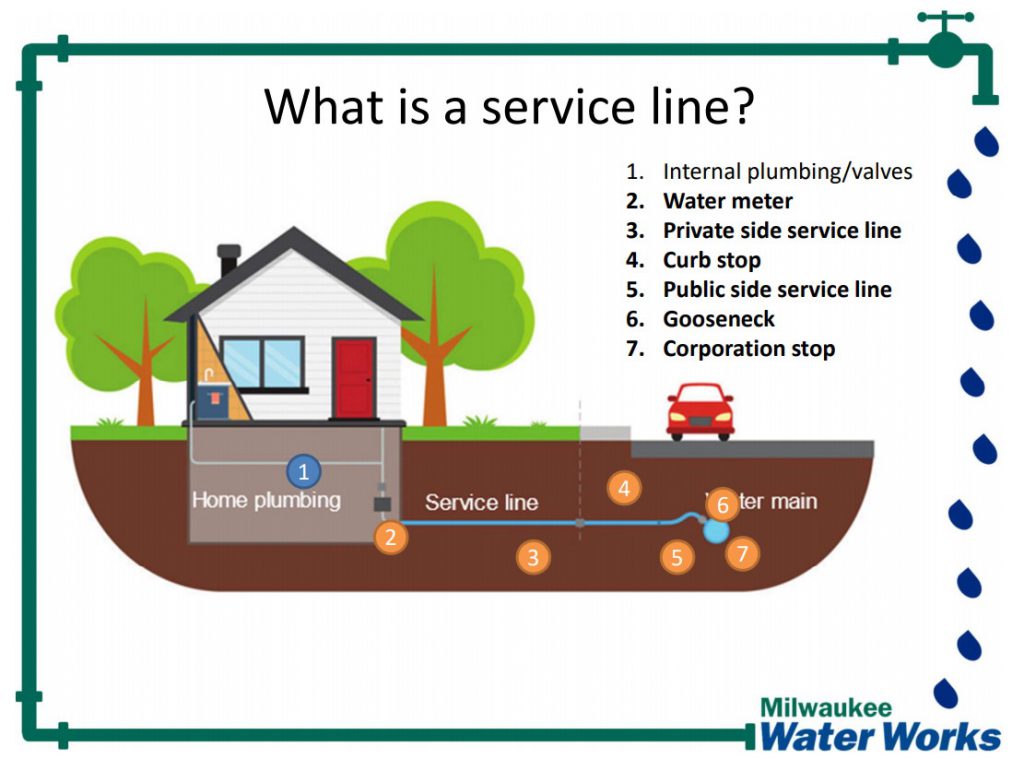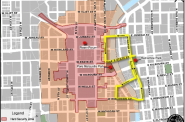Federal Funding for Lead Pipe Removal Likely a Year Away
But Milwaukee Water Works officials were encouraged by show of confidence from VP Harris.
Vice President Kamala Harris was in Milwaukee Monday to tout Wisconsin’s receipt of $48 million for lead lateral removal in 2022 from the Bipartisan Infrastructure Law.
But Milwaukee, which has more than 70,000 lead service lines, might have to wait until 2023 to see some of that money. And even then, Milwaukee Water Works doesn’t know how much or what form it will take.
“The first step in the process is for the [Environmental Protection Agency] to give guidance to the states, which we anticipate will be in February,” said utility administration manager Patrick Pauly to members of the Public Works Committee on Wednesday morning. Pauly is serving as interim superintendent while Superintendent Karen Dettmer serves as interim Public Works Commissioner.
After the state receives guidance on the funding, Pauly said the city anticipates learning in the fall how much Milwaukee could receive and through what mechanisms. The Wisconsin Department of Natural Resources and Department of Administration will administer the funding.
Dettmer noted that the funding could be provided as low-interest or forgivable principal loans. She said the city-owned utility isn’t budgeting for receipt of any of the money in its 2022 plans. MWW targets the replacement of 1,100 laterals per year.
But the waterworks is readying itself to expand its replacement capabilities, she said. “In previous discussions, I’ve described this as a little bit of a bell curve,” Dettmer said. “There will be some ramping up.”
The state is expected to receive federal grants stemming from the infrastructure law for five years.
Pauly said MWW is seeing improved performance and pricing from its contractors, particularly when working on planned replacements. Their work includes replacing both the publicly- and privately-owned portion of the lateral, which connects a property to the city’s water system. Since January 2017 the city has required any replacement to include both sides.
But the utility has seen its progress slow amid the pandemic. It replaced 622 laterals in 2017, 933 in 2018, 1,000 in 2019, 888 in 2020 and 983 in 2021. Most (63%) have been as a result of emergency replacements where a leak or other failure occurred.
The average full replacement cost as of Dec. 31, 2021 was $10,234, according to a MWW report.
“The planned replacements result in quite a bit of cost savings because of the efficiencies involved,” said Pauly, noting that equipment could be staged on streets.
Humboldt Boulevard in Riverwest will be subject to 240 such replacements over two years in advance of the Department of Public Works rebuilding the street. “It’s a huge undertaking,” said Pauly of the 2021-22 project. It also represents a change where the utility is hiring contractors to perform the work on projects that don’t involve water main replacement.
“We have a pool of five contractors who routinely bid on our projects that are advertised,” he said. That includes Hero Plumbing, Five Star Energy Services, MJ Construction, Mid City Corporation and the previously embattled American Sewer Services.
Hero was featured in Harris’ visit to WRTP/BIG STEP and Dettmer said the visit was a “huge vote of confidence” in the city’s program and regional efforts to grow contractor capacity.
Hero, a Black-owned firm, is often contracted by American Sewer Services as part of its bids. “They have been made great strides in being able to perform the service line replacements on their own,” said Pauly. But the MMW leader and Alderman Robert Bauman both noted that plumbers seeking to do the work needed more than the skills, as equipment like a backhoe is required.
Council members also expressed apprehension that American Sewer is still doing work on city jobs after employees brandished weapons and displayed a white supremacy sticker at multiple job sites.
“Weren’t we supposed to ban that organization because they were racist?” asked Ald. Russell W. Stamper, II
“We went through the process of negotiating some concessions with them,” said Dettmer. The company forfeited more than $1.4 million in contracts as a result.
But Stamper thinks more should be done. “Let me update you in private because there are some other concerns you should be aware of,” he said.
What’s The Cost of a Lateral Replacement?
Owners of properties with one to four resident units pay only $1,843 for a city-initiated or break-induced lateral replacement. That’s up from $1,600 when the city program was introduced in 2017.
Bauman and Stamper expressed surprise that the amount changes. The ordinance they voted for in 2016 for includes an annual adjustment calculated by the city clerk. The property owner pays the lesser of either one-third of the average cost of replacing the private side of the lateral or $1,600, adjusted annually for inflation against the constant-quality price index for single-family home construction. That language currently yields a cost of $1,843.
“That’s a significant increase,” Stamper said. Property owners can pay the amount off, plus interest, over 10 years on their tax bills. “I don’t understand indexing and how it keeps going up.”
But based on MWW’s report, the utility expects the rate to actually fall when it is adjusted again on March 1. Based on the Dec. 31 private-side cost of $5,170, the cost would fall to $1,724.33 because it is the lesser of the two calculation methods.
Bauman is pushing for MWW to come up with a plan to make the replacement free or to have an opt-in choice for property owners that aren’t subject to a mandatory replacement. Dettmer and Pauly said any evaluation would need to wait until the infrastructure funding is clear.
The city-owned utility, which sells water to 16 municipalities, is limited on where it can derive funding from to replace laterals based on state utility regulation. It cannot use funds from customers to replace laterals at its own discretion. The utility is currently working on a state rate case to adjust its billing.
UPDATE: An earlier version of this article understated the anticipated future cost for a homeowner required to replace a lateral. It is $1,724, not $1,706. It also misstated the reason the Humboldt Boulevard project represented a policy change. The 1,100 replacements per year is a figure initiated by the Milwaukee Water Works, not the Public Service Commission.
Legislation Link - Urban Milwaukee members see direct links to legislation mentioned in this article. Join today
If you think stories like this are important, become a member of Urban Milwaukee and help support real, independent journalism. Plus you get some cool added benefits.
Related Legislation: File 211520
More about the Lead Crisis
- Gov. Evers Approves Bill to Support Lead Service Line Replacement in Superior - Gov. Tony Evers - Jul 1st, 2025
- MPS’s Westside Academy Cleared of Lead Risks After Stabilization Work - Milwaukee Public Schools - Jul 1st, 2025
- MPS Plans Lead Remediation at 40 Schools This Summer - Evan Casey - Jun 27th, 2025
- Baldwin, Reed Demand Written Answers from RFK, Jr. on Firings of Childhood Lead Poisoning Experts at CDC - U.S. Sen. Tammy Baldwin - Jun 11th, 2025
- MPS’s LaFollette School Cleared of Lead Risks After Stabilization Work - Milwaukee Public Schools - Jun 11th, 2025
- Sen. Baldwin Hears From Parents About MPS Lead Crisis, Chides RFK Jr. - Evan Casey - Jun 9th, 2025
- Reps. Margaret Arney and Darrin Madison Urge Joint Finance Committee to Reinstate Essential Lead Abatement Funding - State Rep. Margaret Arney - Jun 5th, 2025
- Gov. Evers, DHS Continue Administration’s Efforts to Combat Lead Poisoning Statewide with Permanent Rule - Gov. Tony Evers - May 27th, 2025
- RFK Jr. Claims ‘Team’ Is In Milwaukee Helping With Lead Crisis, Health Department Can’t Find Them - Nick Rommel - May 22nd, 2025
- MPS Announces Starms Early Childhood Center Is Cleared of Lead Dangers - Milwaukee Public Schools - May 21st, 2025
Read more about Lead Crisis here

























Didn’t the City decide to use a significant amount of ARPA funds to deal with replacing lead laterals during 2022? Those funds should be available before 2023.
It’s Humboldt Boulevard, not Humboldt Avenue.
Dennis, no ARPA funds were allocated to replacing lead laterals, but the Common Council did allocate a significant amount of ARPA funds to lead paint remediation.
Dennis, no ARPA funds were allocated for replacing lead laterals. The Common Council did allocated significant funds to lead paint remediation.